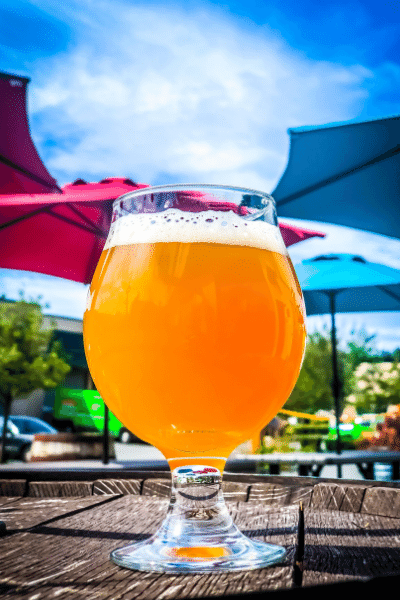There is no doubt that there is a “haze craze” happening in the beer industry right now. There are numerous brews on the market whose visual appearance is remarkably cloudy, but not all beer lovers know how haze is created. What they do know is that hazy beers, particularly IPAs, are not only opaque in appearance, but they offer intense flavor profiles and rich mouthfeel.
A beer’s haze is a result of how the ingredients behave and change during the brewing process, and one of those critical ingredients is hops. Hops are an integral part of the craft brewing experience because of the unique flavors and aromas they impart on the beer as well as the role they play in preservation and a beer’s shelf life. Hops make beer more complex; they add layers of flavor and bitterness, contributing to the beer’s weight and mouthfeel on the palate.
Brewers use hops for a few different reasons: to add bitterness to the brew, to add aroma and flavor, and to create haze or cloudiness. These three elements of hops are carefully adjusted and specified to serve the ever-evolving market and is evident in existing hop-forward beer profiles. Here, we’ll break down what haze is, how it’s created, why consumers are gravitating towards hazy beers, and how SōRSE has made creating haze easier for brewers.
What is Haze?
In the brewing industry, haze is a word describing a beer’s visual appearance – a beer that is not clear or translucent. Brewers also use the word “cloudy,” “opaque,” or “turbid” to describe a hazy brew.
There are a few factors that contribute to a beer’s hazy appearance – namely polyphenols from the hops and proteins in the grain – and how the two interact with each other during the brewing process. Polyphenols are naturally occurring micronutrients in plants. When the polyphenols and the proteins attach to one another, this creates large molecules that are suspended in the beer. In a New England IPA, the haze can be attributed to dry hopping – the process of adding large amounts of hops to the brew after the boil during fermentation. The hops’ polyphenols bond with the beer’s proteins which creates the haze as well as the rich mouthfeel and complex flavors. West Coast IPAs are slightly less hazy than New England IPAs because the hops are added to the kettle earlier in the process, during boil; hops are added in this phase for bitterness and flavor.
Yeast can also contribute to a beer’s haze. At the end of the fermentation process, the yeast wants to combine with other yeast cells, and they will either rise to the top or sink to the bottom – which means the haze of the beer will not be uniform from top of the glass to the bottom.
Why are Consumers Haze-Crazy?
In the early 2000’s, the Heady Topper, a new IPA from the Alchemist brewery in Vermont was released; it is believed to be the first hazy beer to come to market. The brewer had decided not to pasteurize or filter the brew, two processes which extend the shelf life of the beer. The thick, cloudy beer was well-received by the Alchemist’s patrons, as they noted how flavorful, aromatic, and juicy the Heady Topper was. Those qualities can be attributed to the plant and protein particulates that gave the beer its cloudy appearance. Since then, hazy IPAs and other cloudy beers have risen in popularity, because many of the hazy brews offer additional complex sensory qualities to the aroma and/or mouthfeel compared to traditional bright beers.
Emulsion Technology: The Perfect Solution for Creating or Enhancing Haze
For a brewer who wants to enhance their beer’s level of cloudiness and improve the haze’s stability, a hop-derived, water-soluble emulsion can provide the perfect solution. SōRSE has applied its emulsion technology to hops for seamless integration into all beer, NA beer, and cider products. Haze is the combined effect of obscuration of light impacting the product; SōRSE’s emulsion reflects, refracts, and absorbs wavelengths of light.
SōRSE’s Haze Addition product gives a beverage producer the ability to reach the desired level of cloudiness with a single, one-step ingredient without impacting flavor. There is no noticeable impact on the brew’s sensory qualities when using the product, which is achieved by intentionally selecting materials that do not add flavor or aroma, giving brewers full sensory control of their craft.
In terms of creating a stable cloudiness, most traditional methods of creating haze in beer are prone to destabilization; many commercial products drop their haze over time. The stability of SōRSE’s haze product is the result of a paradigm shift in approach. We did not look to develop a stable system; instead, we intentionally created a constantly mixing, chaotic system which maintains the brew’s cloudiness over time.
In terms of integrating Hop Haze into the production process, our “drop and go” solution is easy to use and requires no extra equipment to transform a bright beer into a haze, bold beer. The product format is designed for accuracy and versatility in the dosing process, giving brewers the ability to dose for their desired level of haze and a consistent drinking experience from the first sip to the last. It also saves brewers money with processing time reduced and fewer ingredients used. It is important to know that Haze Addition will potentially have interactions with other materials that are sometimes used in production. The product does not play well with pectin, so brewers should avoid using both in the same system.
If you’re a product developer and are interested in how our Haze Addition product could improve or enhance cloudiness of your beer and stabilize your haze, come to the SōRSE! Check out our Producers Series blog on Hi-Wire Brewing, one of Haze Addition’s lighthouse customers, then request a sample to try for yourself!
Let’s Chat
Want to evaluate our emulsions? We’d love to learn more about your business and work to create a custom solution.
Tell us a little about yourself and we’ll be in touch shortly.
Privacy Policy. All rights reserved 2021.

Let’s Chat
Want to evaluate our emulsions? We’d love to learn more about your business and work to create a custom solution.
Tell us a little about yourself and we’ll be in touch shortly.
Privacy Policy. All rights reserved 2021.

Let’s Chat
Want to evaluate our emulsions? We’d love to learn more about your business and work to create a custom solution.
Tell us a little about yourself and we’ll be in touch shortly.
Privacy Policy. All rights reserved 2021.

A
better
emulsion
Here is our step-by-step guide on water-soluble emulsion technology’s impact on stability.


